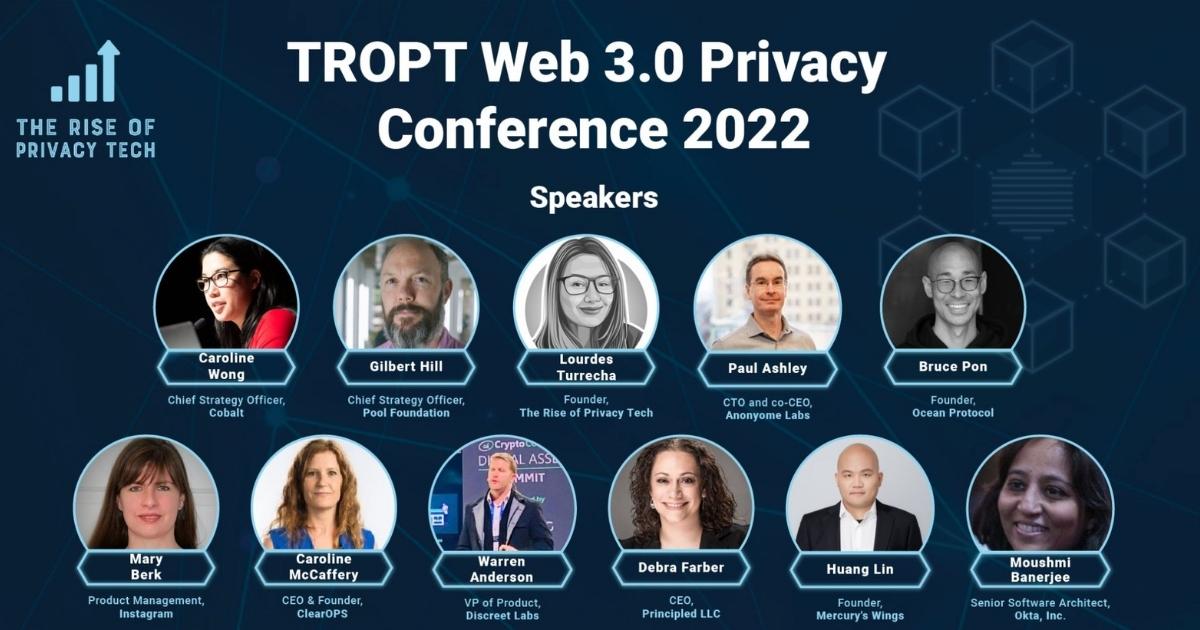Our co-CEO and CTO Dr Paul Ashley was recently invited to present at the TROPT inaugural Web 3.0 Privacy Conference and described some of the developments in decentralized identity that will help to enable Web 3.0, the next iteration of the internet.
Dr Ashley joined Warren Anderson, CEO at Discreet Labs, and Moushmi Banerjee, Senior Software Architect at Okta Inc. at the conference, which attracted hundreds of privacy tech and Web 3.0 key players.
Each panellist described recent privacy developments in the Web 3.0 space, which largely center on decentralized identity (DI). Dr Ashley spoke about digital wallets, verifiable data registries, verifiable credentials and identity hubs. Moushmi Banerjee added to verifiable credentials and explained zero knowledge proofs, while Warren Anderson looked at Discreet Lab’s work in building scalable privacy systems for Web 3.0 and the Findora public blockchain.
If you’re fairly new to Web 3.0 and DI, you might appreciate this context:
What is Web 3.0?
Web 3.0 is the latest iteration of the internet that’s arriving even as Web 2.0 still consumes us. It will shake up data privacy and change the data economy as we know it. Here’s a quick history:
- Web 1.0 was the “read only” web, with static web pages connected with hyperlinks.
- Web 2.0 is the “interactive; anyone can author and share content” web. It has e-commerce and social media and is highly centralized, with web sites and services collecting users’ personally identifiable information in exchange for access (think Meta, Google et al. knowing everything about us). This centralized model has led to surveillance capitalism (the data economy) and the trade of highly profitable personal data for serving up personalized ads and influencing decisions, which in turn has led to widespread data abuse and misuse – and the global data privacy crisis we currently face.
- Web 3.0 promises to solve the privacy and security challenges of its predecessor by flipping the model to decentralized and returning control over personal data to users. It has been called a “decentralized digital infrastructure” because it uses blockchain technology and decentralized identity technology to give users digital identities that aren’t connected to their personal identity (just as Anonyome Labs’ Sudo digital identity has done for years now). In doing so, Web 3.0 moves the user away from being the “product” as a result of their information sharing to being the “owner” of the information they share: they control which pieces of their personally identifiable information (name, date of birth, phone number, SSN etc.) they share in any given context. This essentially means paper and plastic IDs are replaced with digital versions housed in a digital wallet on a user’s device and completely under their control (no centralized authority storing or verifying). On Web 3.0, the user controls where to be identified and where to be anonymous.
What is decentralized identity?
If Web 3.0 will shake things up, then decentralized identity will be doing a lot of the shaking.
Anonyome Labs has long foreseen that, to work, Web 3.0 will depend on decentralized identity (DI) technologies and standards to verify and exchange private information and develop trusted, secure digital relationships between users and services. DI is what will make digital identities being completely under the user’s control possible.
We believe DI delivers everything an effective Web 3.0 application needs:
- Verifiable – allows authorities to issue statements about a subject (e.g. to prove their identity
- Trustless – no requirement on the user to place their sole trust in any one third party in order for a network or payment system to function
- Self-governing – allows users to retain full control over their personal information
- Permissionless – no restrictions, and no central authority or administrator controls participation
- Distributed and robust – stored on blockchain technology, a distributed database that is shared among the nodes of a computer network (as used in cryptocurrency)
- Stateful – all transactions are immutable and stored in the distributed database of the network
- Native built-in payments – facilitates the exchange of payment information
- Standards-based and open source – sets “rules” to enable interoperability across web sites and services.
This video from Microsoft Security explains decentralized identity in simple terms:
This video from Whiteboard Cryto does a great job of explaining Web 3.0:
You might also like to read this article from Free Code Camp: What is Web 3.0? The Decentralized Internet of the Future Explained, and our article, Decentralized Identity: Key Concepts Explained
Since Web 3.0 will depend on decentralized identity as its privacy-enhanced identity layer, Dr Paul Ashley was an obvious choice for the TROPT inaugural panel on the intersection of Web 3.0 and priv tech. Decentralized identify fits easily with Anonyome Lab’s Sudo digital identity model, which is helping to stop the full-scale attack on personal privacy, and is available alongside a range of decentralized identity capabilities through our Sudo Platform SDKs, to help enterprises rapidly develop and deploy customer privacy solutions.
We have written a lot about decentralized identity, including our 5-part blog series which starts here.
Beyond Sudo Platform, Anonyome Labs supports the ongoing development of decentralized identity by:
- helping to run three decentralized identity-focused blockchains
- being an active contributor to the decentralized identity standards organizations
- contributing source code back to the decentralized identity open source community.
We’ll continue to keep you up to date with developments in Web 3.0 and decentralized identity as they happen.
Photo Provided by The Rise of Privacy Tech



